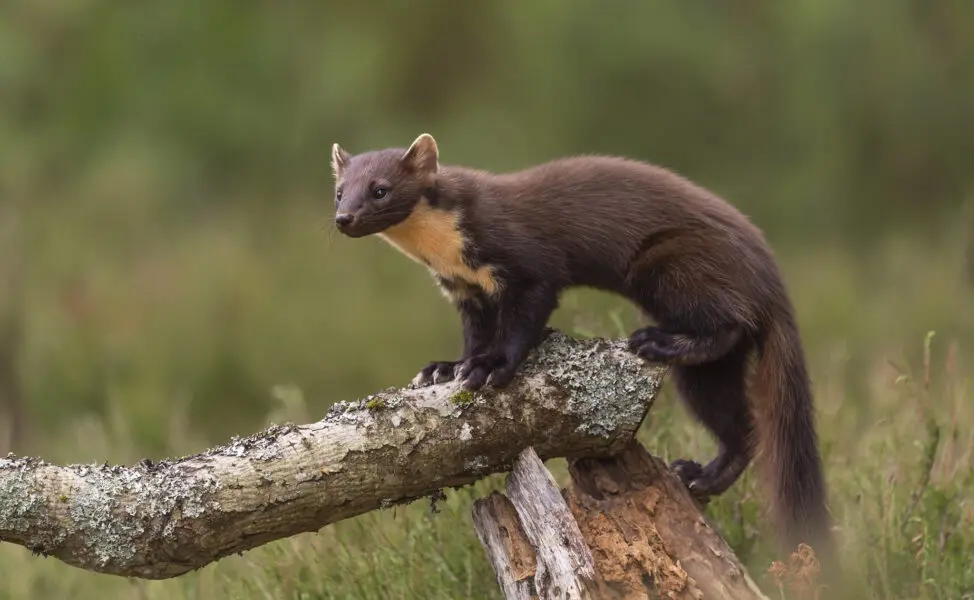
For the first time in over a century, pine martens have returned to Devon.
These arboreal, carnivorous mammals were previously driven to the brink of extinction in the South West by a combination of hunting and a loss of their woodland habitat. Now, thanks to the charity Devon Wildlife Trust and its seven conservation organisations working in partnership, seven male and eight female pine martens have been reintroduced in Dartmoor.
[T]hanks to the charity Devon Wildlife Trust and its seven conservation organisations working in partnership, seven male and eight female pine martens have been reintroduced in Dartmoor.
Pine Martens are Mustelids, meaning they are in the same family of carnivorous mammals as weasels, badgers, and otters. They are extremely agile, which is good for catching prey and avoiding predators (which are predominantly limited to foxes and eagles). Their long tails and strong claws help them move around both on the ground and in the trees. Conservation Manager at Devon Wildlife Trust, Ed Parr Ferris, notes that they even have “reversible rear ankles” which help them climb across branches and down trees.
Pine Martens are omnivores, meaning their diet is made up of berries, fungi, birds eggs, and insects, as well as small animals like mice and rats. Being opportunistic creatures, they will also scavenge from garden bird-feeders if they get the chance; they’ve even been known to have a preference for peanut butter sandwiches!
Before they were released in the South West, the Two Moors Pine Marten Project underwent rigorous ecological assessments, and ecologists from the Dartmoor National Park Authority confirmed that the area was suitable for reintroduction. Pine martens will have a “positive impact on Dartmoor’s biodiversity” according to Emma Williams, a Species Recovery Higher Officer at Natural England.
Pine martens will have a “positive impact on Dartmoor’s biodiversity” according to Emma Williams, a Species Recovery Higher Officer at Natural England.
For example, one of the pine marten’s primary food sources is the invasive grey squirrel species, which makes up 15% of their diet. By supressing the grey squirrel population, it allows for the rare red squirrels to thrive. Squirrel monitoring is an important part of the process as it helps researchers to understand the impact of the reintroduction on other species and their complex relationships.
[O]ne of the pine marten’s primary food sources is the invasive grey squirrel species, which makes up 15% of their diet.
The project is a big step for the region’s woodlands and natural management of the landscape. The idea to reintroduce pine martens to the South West followed from a successful reintroduction story in Wales; after pine martens were seen to be impactful in Scotland, 51 pine martens were released near Aberystwyth between 2015 and 2018. This was the first carnivore recovery programme of its size in Britain.
For the first year after being reintroduced in Wales, the pine martens were closely monitored using radio tracking collars to record their movement and territorial behaviour. After a year, scat surveys and camera traps were used instead. But pine martens are elusive creatures, often living very secretive and solitary lives, making sightings of them very rare. Not to mention they’re nocturnal too, and quick to scurry off! Nevertheless, soon after the reintroduction, citizen scientists, volunteers, researchers, and nature spotters all found sightings to be more common – populations in Mid Wales were on the rise.
For the first year after being reintroduced in Wales, the pine martens were closely monitored using radio tracking collars to record their movement and territorial behaviour.
After this success, 18 pine martens were then relocated to the Forest of Dean in Gloucestershire, just up the M5 from Exeter, in 2019. This relocation took place after the positive conclusion of extensive ecological and social feasibility studies. In spring 2020, populations were not only seen to increase, but also disperse, which is encouraging for the expansion of future populations.
And now, as of autumn 2024, pine martens can be seen in Devon again – if only on the lucky rare occasion that you encounter one! The tree-dwelling animal will be monitored in the same way as previous projects of the same nature, as experts assert this method is exemplar of best practice.
And now, as of autumn 2024, pine martens can be seen in Devon again – if only on the lucky rare occasion that you encounter one!
Pine martens will “restore entire woodland ecosystems by reinstating natural processes that humans have disrupted”, says Abigail Parravani, a Forestry England forest planner. It is expected that the population will grow gradually over the coming years like in other projects around the UK.
The second phase will occur in Exmoor, where a further reintroduction is planned for this year.


